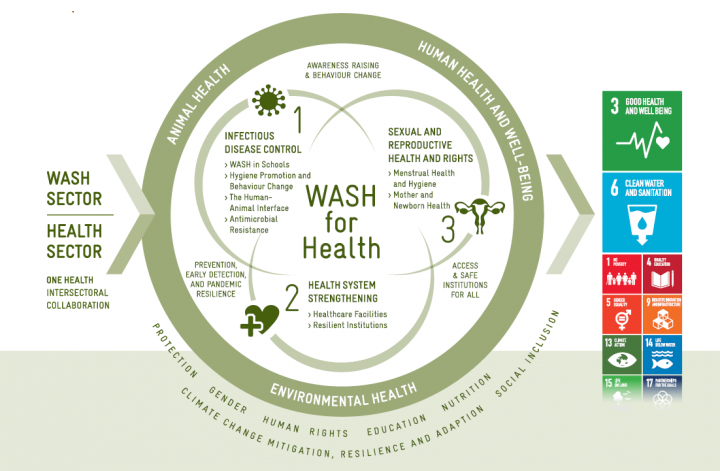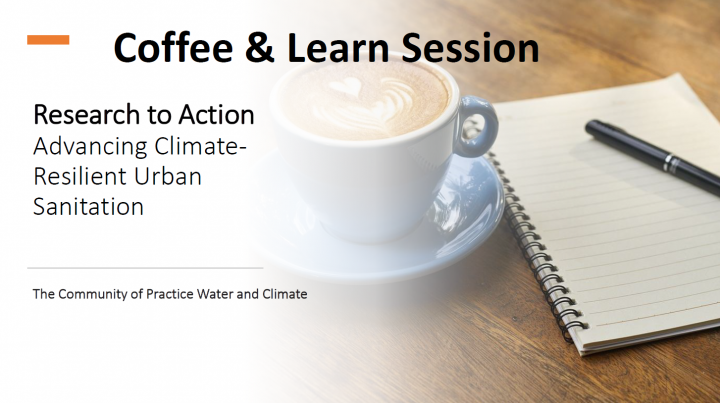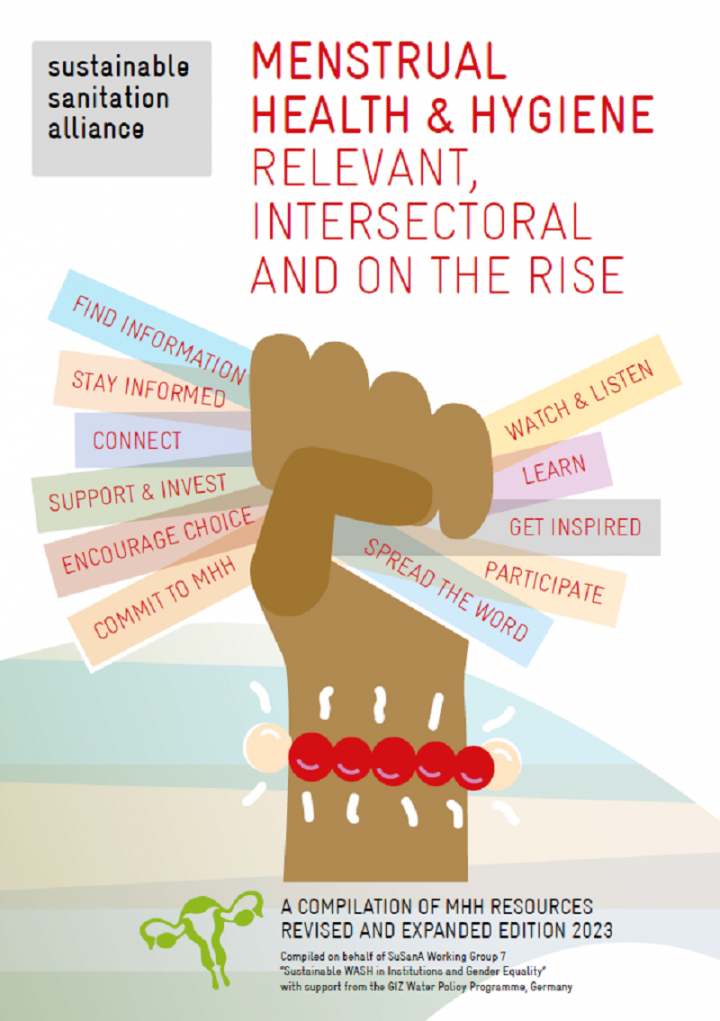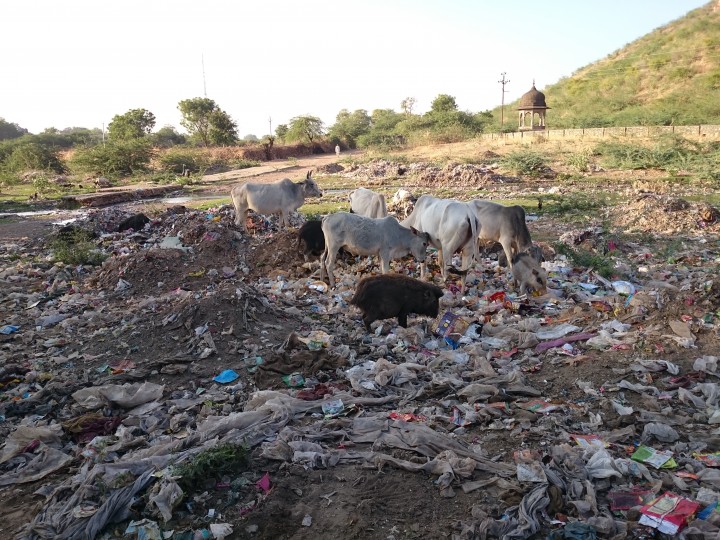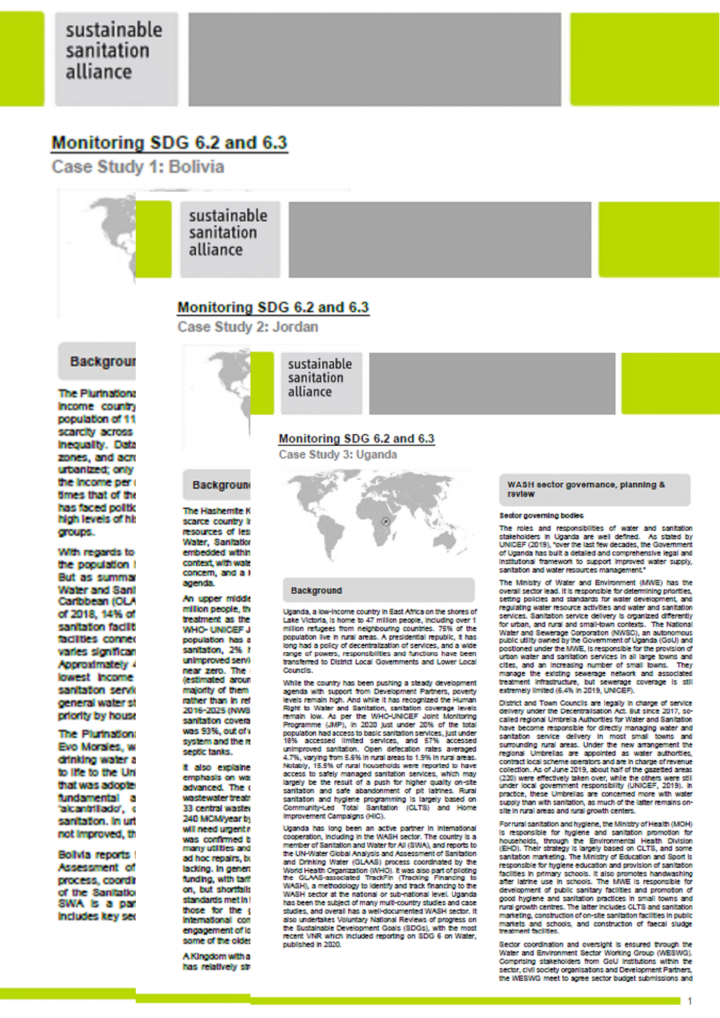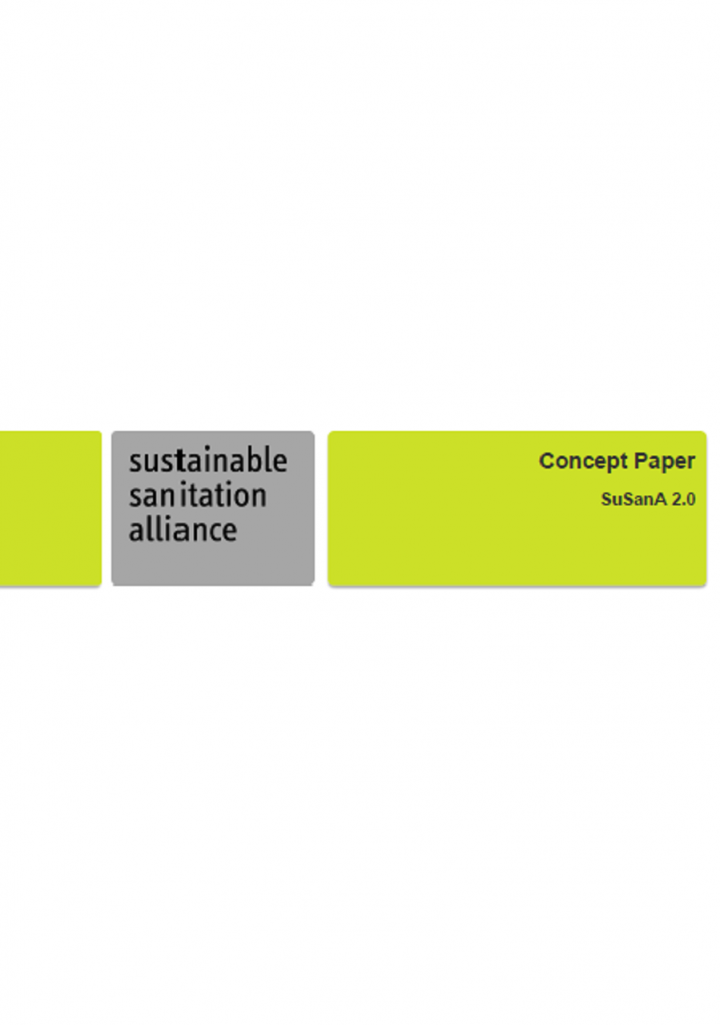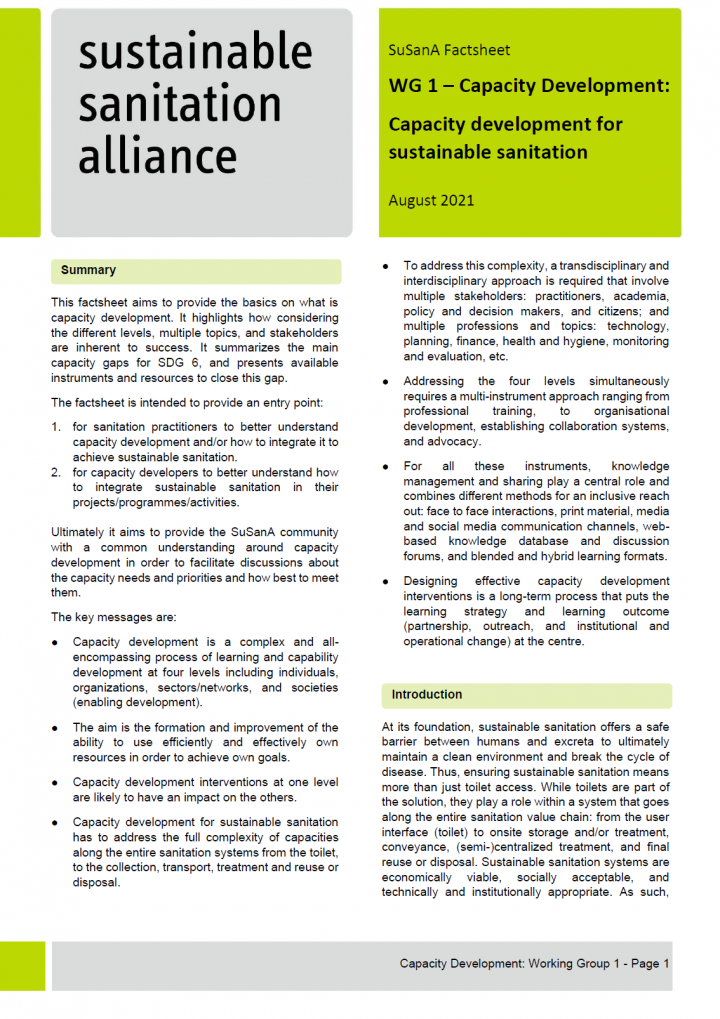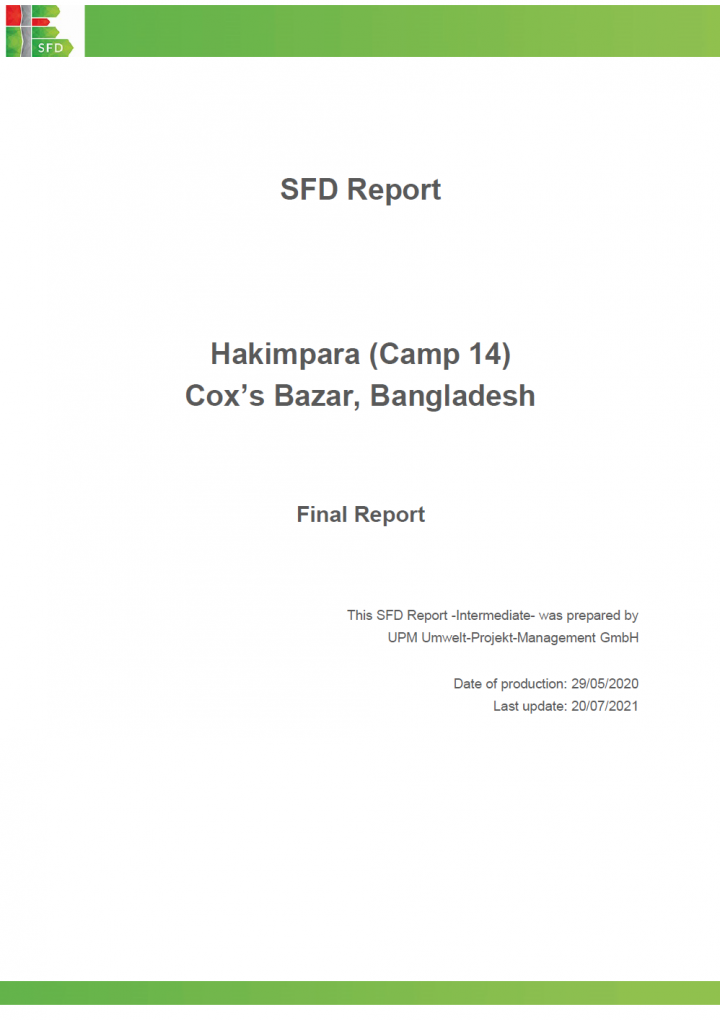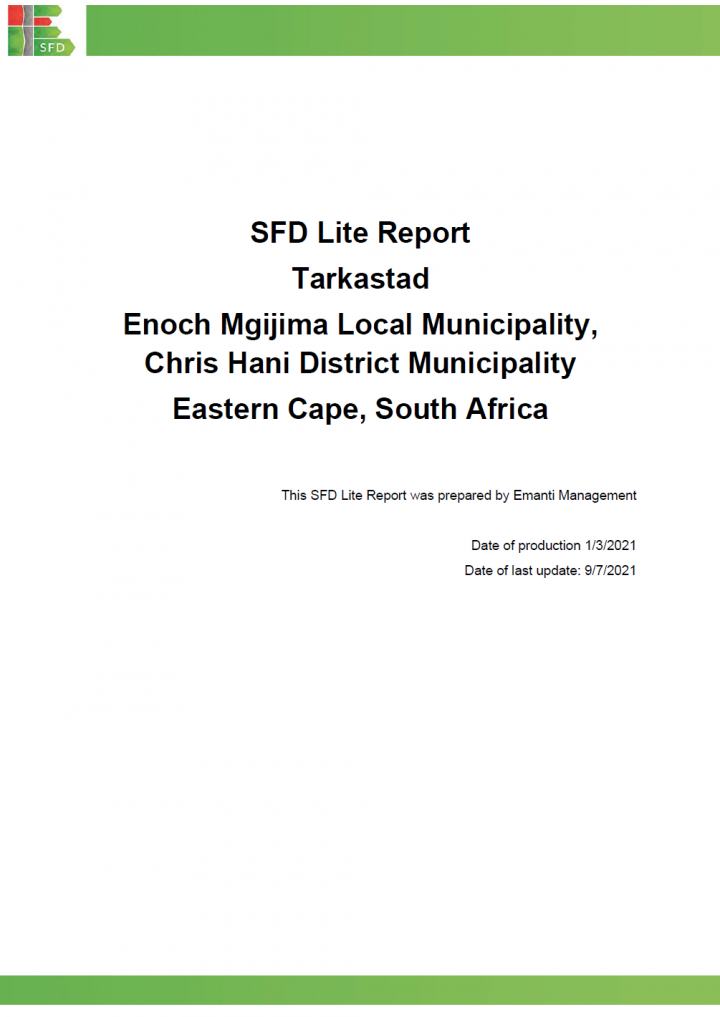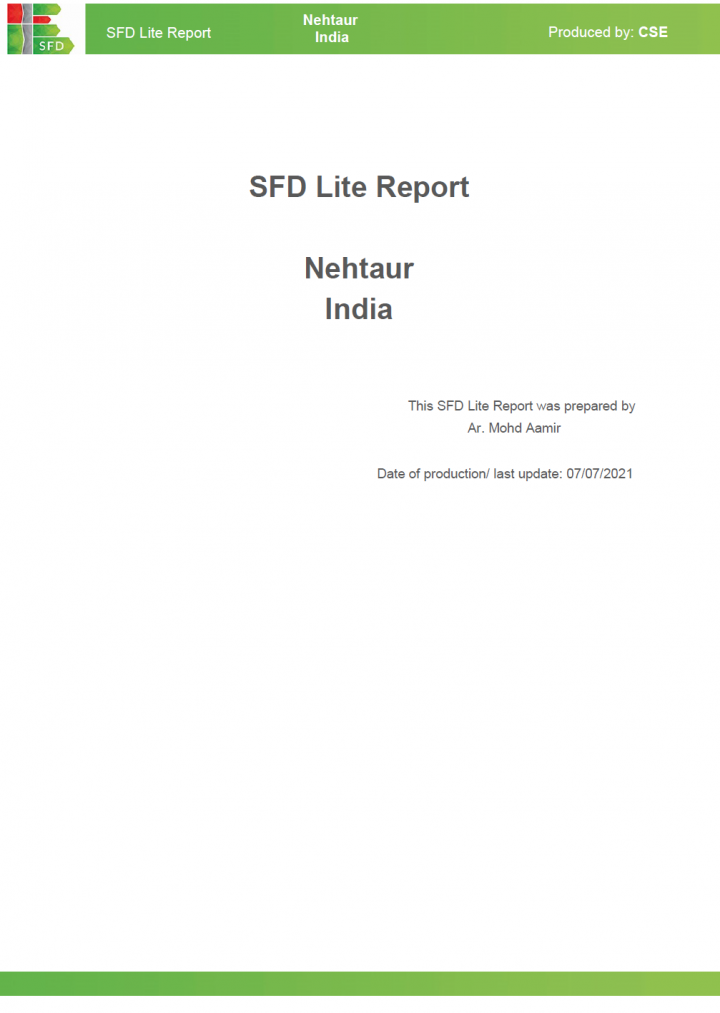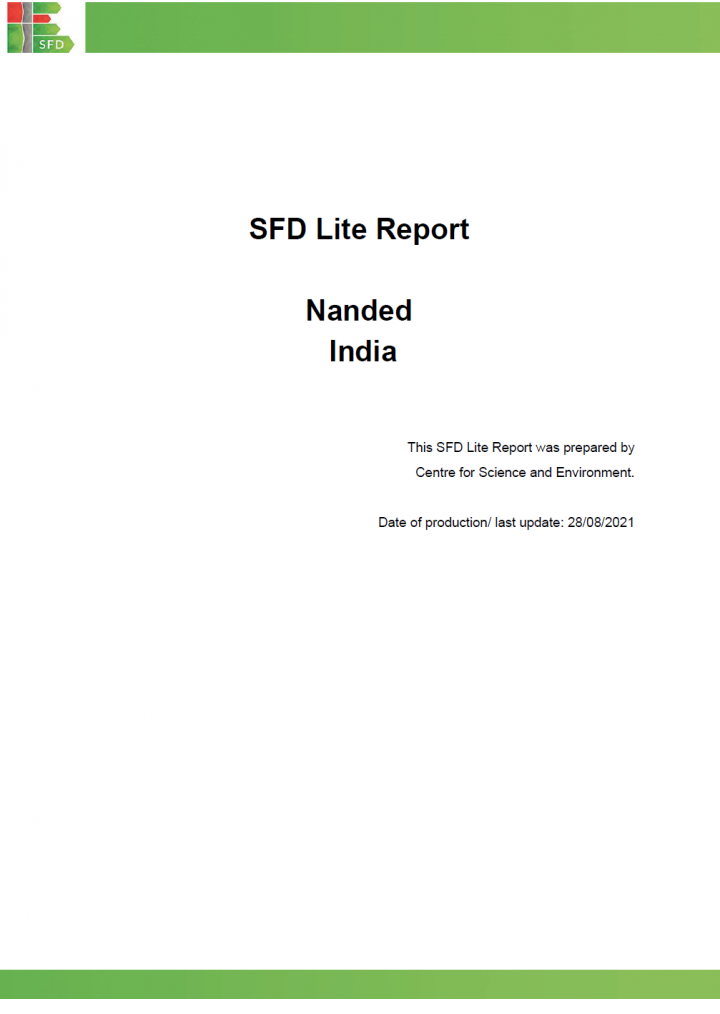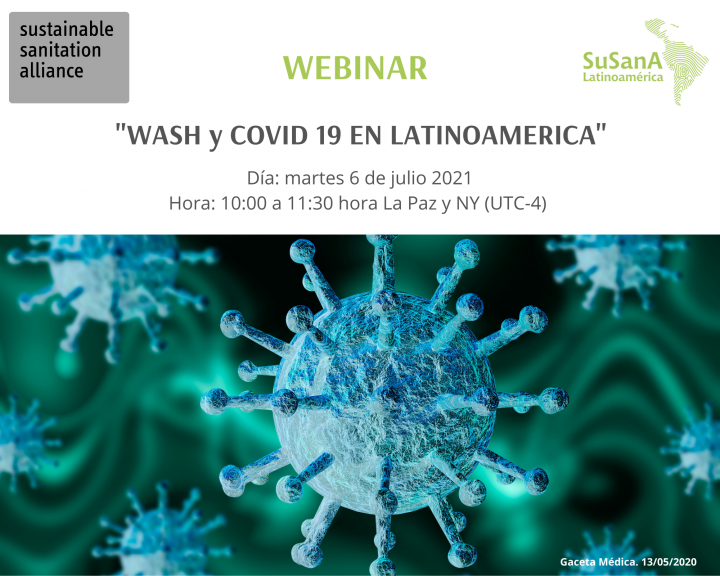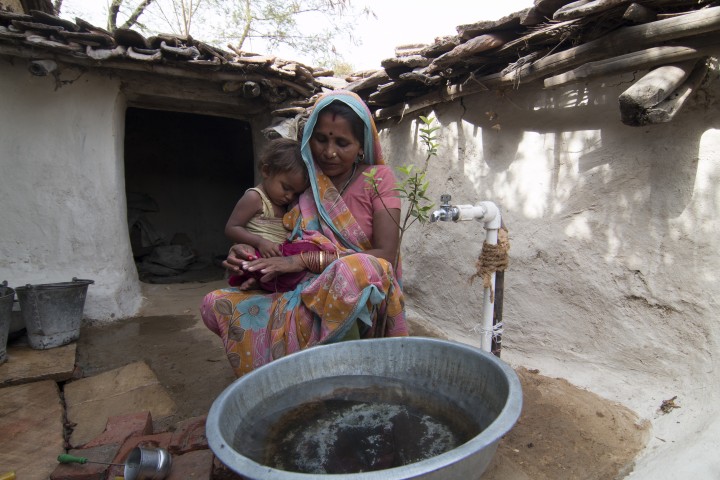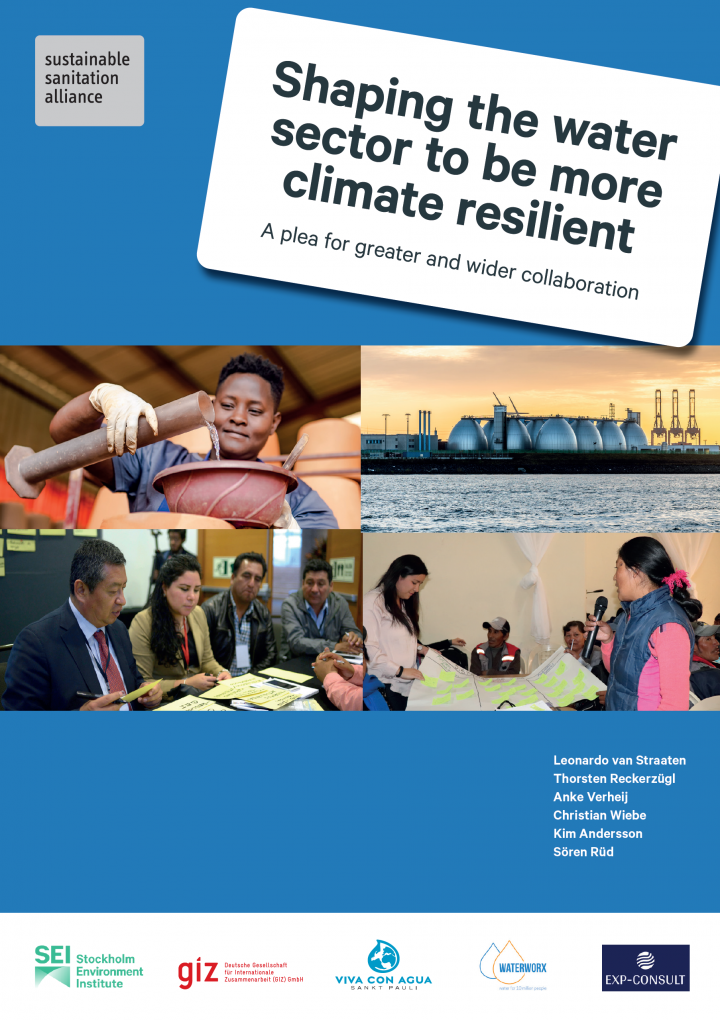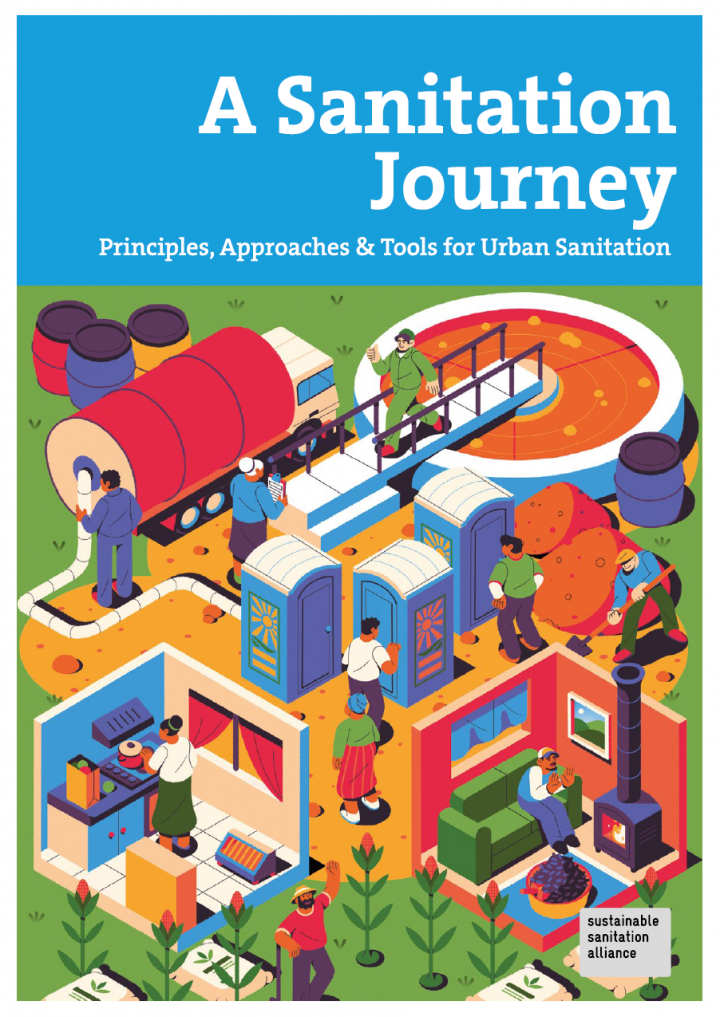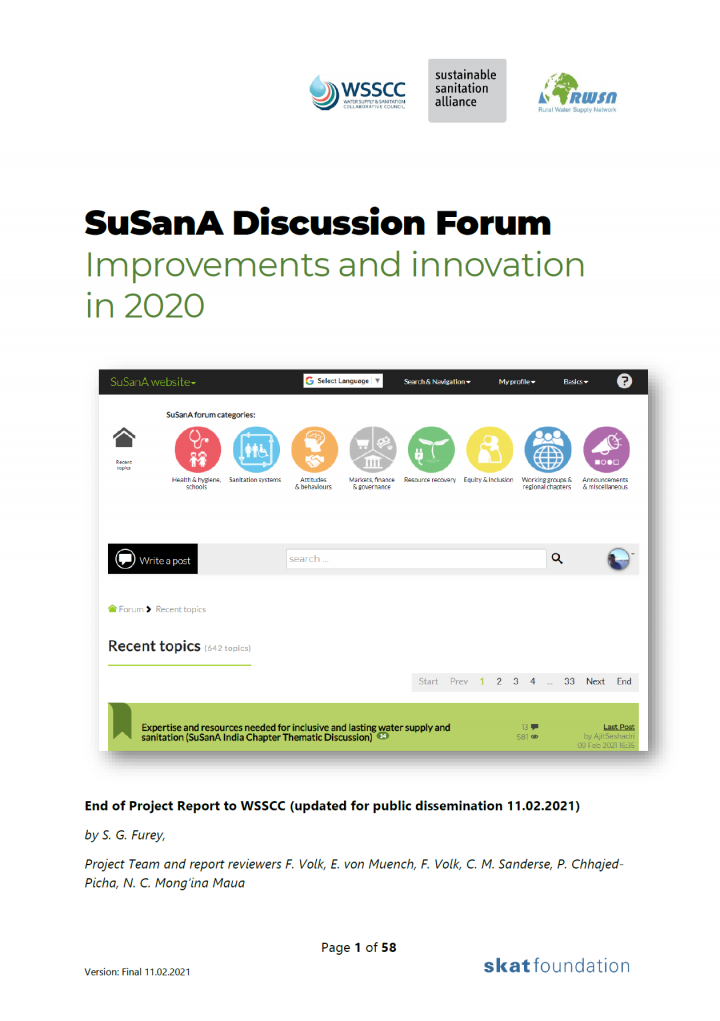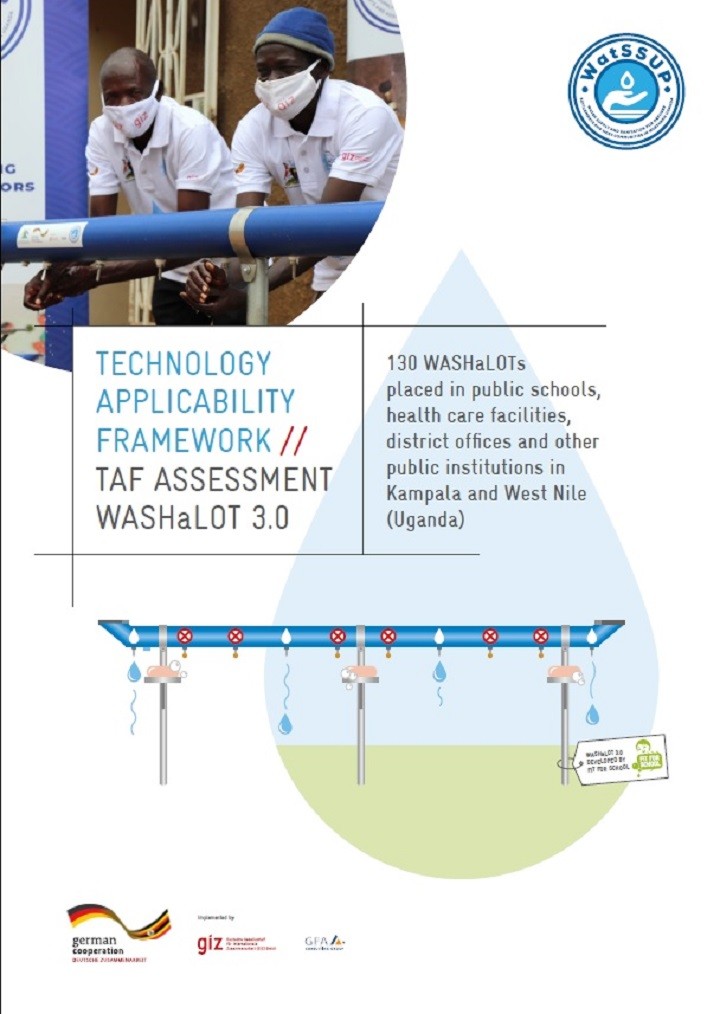Searching for information on Sanitation Workers?
The Sanitation Workers Knowledge + Learning Hub is the best source for all current news, trends, articles and updates on sanitation workers rights around the world.
The 34th SuSanA meeting took place on 24th August 2024. It was organised by the SuSanA Secretariat with support and contributions from the Global Steering Commitee, SuSanA Partners, Members, Working Groups, Regional Chapters and many more.
This entry is the collection point of the different resources from the SuSanA Meeting, including recordings, presentations and program overview.
We once …
The WASH for Health approach presents significant opportunities for advancing not only SDG 3 (Good Health and Wellbeing) and SDG 6 (Clean Water and Sanitation) through improving public health outcomes, including WASH in infectious disease control, health system strengthening, and sexual and reproductive health and rights. Adopting the One Health approach provides a broader perspective, …
The SuSanA Secretariat and University of Technology, Sydney (UTS) were invited by the GIZ Community of Practice "Water and Climate" to a webinar, which took place on the 25th July 2023.
This transformative Coffee & Learn session bridges the gap between research and project implementation. As climate change poses an increasing threat to urban sanitation services, it is crucial to stay ahead of …
The 4th edition of a comprehensive compilation of menstrual health and hygiene (MHH) resources provides an overview and categorization of the key resources available to date. This publication brings together a wealth of resources, including research, case studies, project examples, and informational materials for everyone interested in MHH.
Its main purpose is to offer individuals and …
As the Swachh Bharat Mission of the Government of India expands, solid waste management will have to keep pace. This thematic discussion on the India Chapter of SuSanA examines the readiness of local government institutions, tasked with the job, to effectively plan and implement solid waste management systems.
Faecal sludge management in rural areas is a fast emerging as a challenge as most toilets are single pits or containment tanks. The FSM chain, from containment and collection through transportation and treatment followed by safe reuse is very new and tenuous. While SBM II guidelines provide limited approaches, it was felt that a decision-support mechanism was needed. This thematic discussion …
In line with the expression ‘you manage what you measure’, high quality and regular monitoring is key for the successful achievement of SDG targets 6.2 and 6.3. SuSanA’s Vision Document states the intention to further its work to meet the increasing need for technical assistance in developing methodologies, designing monitoring structures compatible with existing technical and institutional …
Since its foundation in 2007, SuSanA has grown to become a very large, and at times influential, network of organisations and individuals on sustainable sanitation. Its growth has contributed to challenges related to its model of structure, governance and operations, and the Bill and Melinda Gates Foundation commissioned a consultancy in 2018 to consider how SuSanA could re-shape for a new era in …
This document will show you everything you need to know about the SuSanA platform and all the resources that it offers including:
- The SuSanA partner profiles,
- Discussion forum
- Working groups
- Social media
- Thematic Discussions
- Hosting of SuSanA events
- Online library
- SuSanA newsmail
In the file download section below you will find:
- The Welcome Package for new …
The present document consists of an addendum of data to the Handbook of Methods for Faecal Sludge Analysis. It is part of a project funded by the Bill & Melinda Gates (BMGF) through the OPP1164143, untitled “Characterization of faecal material during drying”. This project was granted for funding after the 5-years Transformative Technologies convening at the BMGF headquarters in 2016, where …
Images are a big part of communication, today more so than ever. Not only do we consume more visual media than ever through social media and streaming sites. More and more we use images to communicate with each other, e.g. gifs and memes. Yet the way we read and understand an image is influenced by several factors including historical and cultural context or background, age as well as race and …
This factsheet aims to provide the basics on what is capacity development. It highlights how considering the different levels, multiple topics, and stakeholders are inherent to success. It summarizes the main capacity gaps for SDG 6, and presents available instruments and resources to close this gap.
The factsheet is intended to provide an entry point:
1. for sanitation practitioners to …
This SFD report looks at Hakimpara, Camp 14, a sub-division of a larger Rohingya refugee camp site in Palong Khali union, Teknaf upazila, Cox’s Bazar District (CXB District) in Bangladesh. As for end February 2021, there were 32,815 people registered in Camp 14 and over 870,000 people (Inter Sector Coordination Group - ISCG 2021 & UNHCR 23.03.2021) registered in total in the 34 sub-camps and in …
Tarkastad (GPS coordinates: 32.0048 S, 26.2717 E) is a primary development node and serves as the local administrative centre for Enoch Mgijima LM (Enoch Mgijima Local Municipality, 2017). Tarkastad used to form part of the Tsolwana Municipality which was subsequently absorbed as part of the Enoch Mgijima LM. Tarkastad initially developed as a farming area and later as a church centre and a …
Nehtaur is a small town in Bijnor District, Uttar Pradesh and is located 26 km to East of BijnorNehtaur is a small town in Bijnor District, Uttar Pradesh and is located 26 km to East of Bijnorcity, District Headquarters (Figure 2). According to Census 2011, Nehtaur had a populationof 47,834 residing in 7,438 households (HHs). The population of the city as per SwachhSurvekshan (country wide annual …
Nanded is a historical city located in the Marathwada region of Maharashtra State in India (Annex 1 and Annex 2)1. Nanded Waghala is regarded as the second most holy city after Amritsar due to the presence of Gurdwara Takhat Shri Hazur Sahib, one of the five Takhats of the Sikh community2. Nanded is also the second-largest city in the Marathwada region of Maharashtra and the 81st popular city in …
Gurugram, located 30 kilometres (km) southwest of the national capital of New Delhi, etymologically traces its roots to the ancient legend of Guru Dronacharya (Figure 2). The city is located at 28o 7’21” N and 77o 1’44” E with a mean elevation of 217 m above sea level. While there are no perennial rivers in the city, smaller seasonal streams drain the city which have been concretized as …
En el inicio de COVID 19, la Sesión Stepping Stone - Capítulo de América Latina compartió ejemplos de soluciones y acciones durante la situación de pandemia sobre los siguientes temas.
1. Campaña Nicaragua Saludable y el Análisis de los retos de los CAPS para asegurar la sostenibilidad de los servicios de agua potable en el contexto de COVID 19
2. Covid-19 y las barreras al agua …
The COVID-19 pandemic has affected women more than men in several ways, according to studies. They have had to take care of patients while coping with lock-downs that have restricted access to daily necessities and basic services, including water, sanitation and hygiene. At the same time, however, women have shown great strength and leader-ship in managing the uncertainties and challenges …
El 22 de marzo es el Día Mundial del Agua cuyo lema este 2021 es: el Valor del Agua. Con motivo de este día, Naciones Unidas ha lanzado la campaña #Water2me para conocer el significado que tiene el agua para el planeta con el objetivo de encontrar las mejores soluciones que aseguren su conservación y protección. SuSanA Latinoamérica se une a esta iniciativa lanzando este seminario virtual …
Celebrating World Water Day 2021 on March 22nd, six experts, backed by five organizations (Stockholm Environment Institute, GIZ, Viva con Agua, WaterWorX and EXP-Consult) present a plea for greater and wider collaboration to shape the water sector to become more climate resilient. Improved management of water and sanitation services is fundamental not only for climate change adaptation but also …
Sanitation and hygiene are the foundation of healthy cities. They are a primary prerequisite for the health of our societies as well as economic development. However, achieving safe and sustainable urban sanitation for all has proven to be difficult, especially for the vulnerable and poor.
The publication "A Sanitation Journey - Principles, Approaches and Tools for Urban Sanitation" provides …
From the executive summary:
• This report summarises the work done under a grant from WSSCC (via UNOPS Geneva) to Skat Foundation to run and develop the SuSanA Forum.
• The SuSanA Forum is a well-established, vibrant online community within the sanitation sector and a major global knowledge exchange hub on topics relating to practical implementation, research and policy. It is an …
130 WASHaLOTs placed in public schools, health care facilities, district offices and other public institutions in Kampala and West Nile (Uganda).
In a participatory process, a technology implemented as a pilot is assessed through the perspective of three key stakeholder groups engaged with the implementation of the technology: user/buyer, producer/provider and regulator/ investor/facilitator. …


